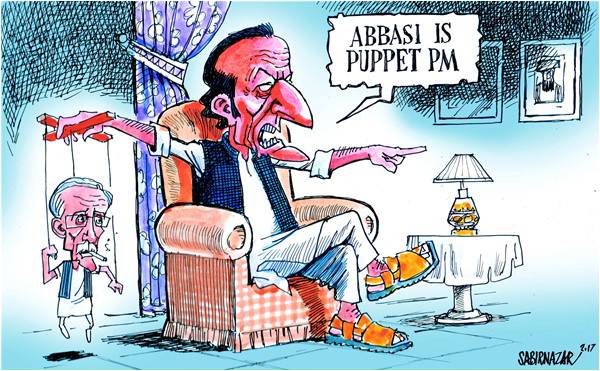
The PPP is turning fifty on November 30. When it was launched, it was a party of fervent hope. Now it is a party of despair. It once promised radical change. Now it enshrines the status quo. It used to straddle the nation. Now it hunkers down in rural Sindh. It fertilized the struggle for democracy with the blood of four Bhuttos. Now it cowers in fear under a Zardari. How did this come about? What are the consequences of this for Pakistan’s state and society?
Zulfikar Ali Bhutto was a feudal aristocrat who served a military dictator. But he turned against his mentor and roused the working classes with the promise of “roti, kapra aur makaan”. Then he allied with the Miltablishment to cut East Pakistani aspirations to size, in the process losing half of Pakistan. Shortly after becoming President and Martial Law Administrator in 1972, he pitted the “power of the state against the power of the street”, progressively got rid of his “comrades” and by the mid-70s, had returned the PPP to the fold of the landowning classes. He gave the country its first democratic-federal constitution in 1973, then eroded it by sacking two provincial governments and imprisoning their leaders and parliamentarians. He envisioned the rise of “petrodollar Islam” in the Middle-East and enabled Pakistanis to be employed abroad, creating a solid base for foreign remittances that have kept the homeland afloat all these years. Then he launched an “Islamic bomb” program as wherewithal for leading a Muslim-Arab bloc in competition with the Third World’s Non-Aligned Movement and the West’s NATO, in consequence arousing the wrath of the US and paving the way for his overthrow by the pro-US Miltablishment and execution by its handmaiden judiciary.
Indeed, the one legacy that has outlived him and become a millstone around the neck of Pakistani state and society was his decision to politicize the religion of Islam. He brought “Islam” into the sloganeering equation of “democracy and socialism”. He bowed before majoritarian Islamists to outlaw the Ahmedis; he affiliated with Islamic despots in the Middle East and Africa for the crumbs of their rising petrodollar wealth. This eventually paved the way for General Zia ul Haq to push the “Islamic” envelope and “Islamise” state and society with horrendous consequences.
Benazir Bhutto was bold and beautiful. She discreetly removed the Islamic and Socialist provisions of the PPP’s manifesto and stuck faithfully to the notion of a tolerant, liberal democracy. But the Miltablishment charged her with inexperience, incompetence and corruption and got rid of her not once but twice. She lost popular support whenever she was booted out and was assassinated when she made a third heroic attempt to set things right. Her successor Asif Zardari inherited a national party in mourning and hastened its demise by antagonizing the Miltablishment, alienating the Judiciary and abandoning the poor and downtrodden who formed the core support base of the PPP. Now, relegated to the backwaters of rural Sindh on the shoulders of a corrupt and incompetent rural feudal elite that is sustaining itself on the opiate of ethnic nationalism, the PPP is bending and bowing to mend fences with the very middle-class, urbanized Miltablishment that has been the bane of its existence.
The relegation of the PPP to the status of a regional rural party is a national tragedy. It was the only party in Pakistan’s history that espoused, however haltingly and imperfectly, a liberal constitutional state at peace with itself and with its neighbours. Its progressive demise has run parallel with the consolidation of a reactionary, militarized state at war with itself and with its neighbours. Its political space was first lost nationally to the PMLN allied to the Miltablishment and, following the latter’s split after Nawaz Sharif breached the civil-military balance of power, to the PTI allied to the same Miltablishment. The PPP’s regional space is now at risk from the Muhajir parties and groups in urban Sindh allied to the Miltablishment. Its political tragedy is all the more profound since Pakistan’s demography is consolidating around an urban middle class political culture while the PPP is retreating into a rural feudalistic stranglehold.
Both the PPP and PMLN now stand at the crossroads of history. As the two leading mainstream, non-religious, national, centrist parties, both have won and lost against each other on the back of the Miltablishment. In the process, however, they have hurt each other’s prospects while strengthening the Miltablishment. One has been sidelined and the other is now being readied for the chop. Both now face the spectre of a rising Third Force in the shape of an intolerant, vengeful, fascist PTI in alliance with the Miltablishment and Judiciary, spearheaded by an angry, conservative, urbanized, youthful middle-class baying for “freedom” from both.
It stands to reason, therefore, that the PPP’s political downslide can only be halted by a holy political alliance with the PMLN against the Miltablishment backed PTI, Muhajir and Islamist parties. Unfortunately, however, personal affronts and egos stand in the way of a grand political strategy to save themselves and Pakistan.
Zulfikar Ali Bhutto was a feudal aristocrat who served a military dictator. But he turned against his mentor and roused the working classes with the promise of “roti, kapra aur makaan”. Then he allied with the Miltablishment to cut East Pakistani aspirations to size, in the process losing half of Pakistan. Shortly after becoming President and Martial Law Administrator in 1972, he pitted the “power of the state against the power of the street”, progressively got rid of his “comrades” and by the mid-70s, had returned the PPP to the fold of the landowning classes. He gave the country its first democratic-federal constitution in 1973, then eroded it by sacking two provincial governments and imprisoning their leaders and parliamentarians. He envisioned the rise of “petrodollar Islam” in the Middle-East and enabled Pakistanis to be employed abroad, creating a solid base for foreign remittances that have kept the homeland afloat all these years. Then he launched an “Islamic bomb” program as wherewithal for leading a Muslim-Arab bloc in competition with the Third World’s Non-Aligned Movement and the West’s NATO, in consequence arousing the wrath of the US and paving the way for his overthrow by the pro-US Miltablishment and execution by its handmaiden judiciary.
Indeed, the one legacy that has outlived him and become a millstone around the neck of Pakistani state and society was his decision to politicize the religion of Islam. He brought “Islam” into the sloganeering equation of “democracy and socialism”. He bowed before majoritarian Islamists to outlaw the Ahmedis; he affiliated with Islamic despots in the Middle East and Africa for the crumbs of their rising petrodollar wealth. This eventually paved the way for General Zia ul Haq to push the “Islamic” envelope and “Islamise” state and society with horrendous consequences.
Benazir Bhutto was bold and beautiful. She discreetly removed the Islamic and Socialist provisions of the PPP’s manifesto and stuck faithfully to the notion of a tolerant, liberal democracy. But the Miltablishment charged her with inexperience, incompetence and corruption and got rid of her not once but twice. She lost popular support whenever she was booted out and was assassinated when she made a third heroic attempt to set things right. Her successor Asif Zardari inherited a national party in mourning and hastened its demise by antagonizing the Miltablishment, alienating the Judiciary and abandoning the poor and downtrodden who formed the core support base of the PPP. Now, relegated to the backwaters of rural Sindh on the shoulders of a corrupt and incompetent rural feudal elite that is sustaining itself on the opiate of ethnic nationalism, the PPP is bending and bowing to mend fences with the very middle-class, urbanized Miltablishment that has been the bane of its existence.
The relegation of the PPP to the status of a regional rural party is a national tragedy. It was the only party in Pakistan’s history that espoused, however haltingly and imperfectly, a liberal constitutional state at peace with itself and with its neighbours. Its progressive demise has run parallel with the consolidation of a reactionary, militarized state at war with itself and with its neighbours. Its political space was first lost nationally to the PMLN allied to the Miltablishment and, following the latter’s split after Nawaz Sharif breached the civil-military balance of power, to the PTI allied to the same Miltablishment. The PPP’s regional space is now at risk from the Muhajir parties and groups in urban Sindh allied to the Miltablishment. Its political tragedy is all the more profound since Pakistan’s demography is consolidating around an urban middle class political culture while the PPP is retreating into a rural feudalistic stranglehold.
Both the PPP and PMLN now stand at the crossroads of history. As the two leading mainstream, non-religious, national, centrist parties, both have won and lost against each other on the back of the Miltablishment. In the process, however, they have hurt each other’s prospects while strengthening the Miltablishment. One has been sidelined and the other is now being readied for the chop. Both now face the spectre of a rising Third Force in the shape of an intolerant, vengeful, fascist PTI in alliance with the Miltablishment and Judiciary, spearheaded by an angry, conservative, urbanized, youthful middle-class baying for “freedom” from both.
It stands to reason, therefore, that the PPP’s political downslide can only be halted by a holy political alliance with the PMLN against the Miltablishment backed PTI, Muhajir and Islamist parties. Unfortunately, however, personal affronts and egos stand in the way of a grand political strategy to save themselves and Pakistan.

